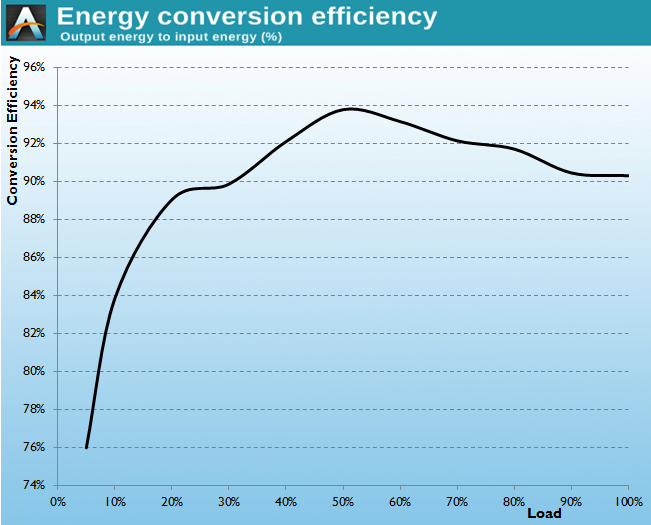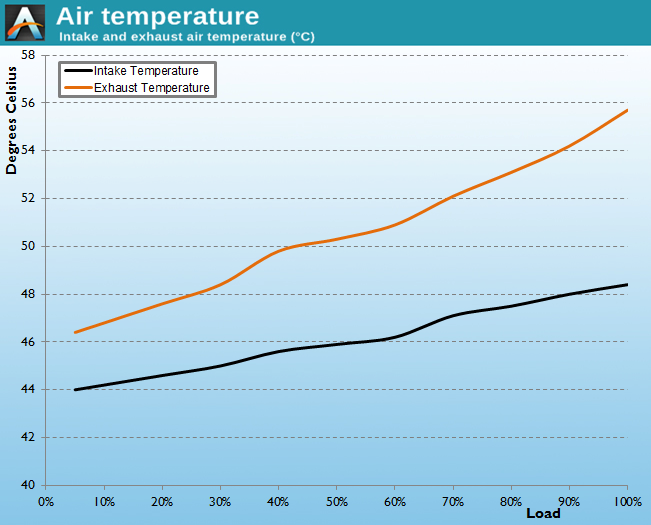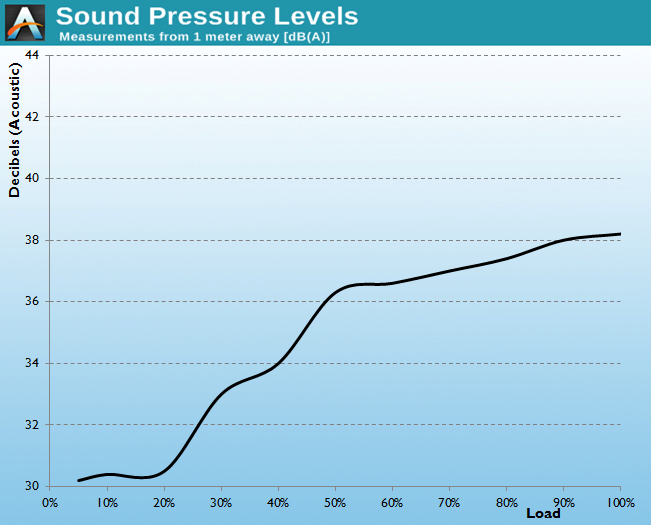Seasonic S12G 650W Power Supply Review
by E. Fylladitakis on February 28, 2014 2:20 PM EST- Posted in
- Cases/Cooling/PSUs
- Seasonic
- 80 Plus Gold
Hot Test Results
From the table below, it can be seen that the output power quality of the Seasonic S12G is very high. The maximum voltage ripple that our instrumentation recorded is a mere third of the ATX design guide suggested limit (the limits are 120 mV on the 12V line, 50 mV on the minor voltage lines), under full load and inside the hotbox no less. Cross-load testing negatively affects the power quality of any power supply but its effect on the Seasonic S12G is small, with the 12V line registering up to 54 mV while delivering 512W. Cross-load testing has virtually no effect on the minor voltage lines, the performance of which did not degrade any further than during standard testing.
| Line |
Regulation (20-100% load) |
Voltage Ripple (mV) | |||||
| 20% Load | 50% Load | 75% Load | 100% Load |
CL1 12V |
CL2 3.3V + 5V |
||
| 3.3V | 2.1% | 6 | 8 | 12 | 14 | 6 | 12 |
| 5V | 2.6% | 8 | 12 | 12 | 16 | 6 | 16 |
| 12V | 1.7% | 14 | 22 | 30 | 46 | 54 | 16 |
The impact that the higher ambient temperature has on the energy conversion efficiency is rather small, reducing the efficiency of the Seasonic S12G by about 0.5% across the entire load range. As such, the Seasonic S12G easily retains its 80 Plus Gold efficiency certification status even inside a very hot environment. The average efficiency between 20% and 100% load is an extremely high 91.6%.
The difference between our cold and hot tests is an increase of over 20°C ambient and, naturally, all of the temperature readings increase significantly. We dare say that the temperatures of the heatsinks rise quite a bit beyond our expectations of an 80 Plus Gold unit by Seasonic; however, the heatsinks are rather small and the design of the power supply apparently focuses on low-noise operation, so sacrifices are made in the area of temperatures.
The low-noise aptitude of the Seasonic S12G becomes apparent when we see that the fan hardly exceeds 38 dB(A) under the harshest of conditions, which is an audible figure but hardly louder than three or four 3.5" mechanical disks -- and never mind the GPUs that would be required to hit such loads. Nevertheless, unless you somehow manage to maintain the unit at maximum load inside a >50 °C environment, the Seasonic S12G will not get nearly hot enough to cause problems.














77 Comments
View All Comments
tynopik - Monday, March 3, 2014 - link
> Shorting a component = OCP protection. I always perform such tests before proceeding to testing the unit.good to know, thanks
> Still, that is not a fault of the PSU, it is an issue with your energy supplier.
Disagree. No matter what the input is to a power supply, there are only 2 acceptable outputs: in-spec power or nothing.
It should NEVER put out-of-spec power on the rails, period.
RAYBOYD44 - Monday, March 3, 2014 - link
My Uncle Jordan recently got Lexus GX 460 SUV from only workin on a pc at home...GrahamATrotmann - Monday, March 3, 2014 - link
n a PSU with a fan. Waste of money when my main reason for getting it was negated. I heard the new generations of Seasonic are almost always silent, but I'm happy with the SilentNight, too. http://num.to/4257*9142*5469Ram21 - Monday, March 3, 2014 - link
So, maybe I am blind, but how long are the cables? In previous power supply reviews, there were info graphics that had the lengths each type of cable. Great review, and looking forward to seeing more reviews with this level of detail.HangFire - Tuesday, March 4, 2014 - link
I agree! While mundane, cable lengths and connector types and counts are an essential part of any power supply review. Anyone buying a power supply is doing so for a reason, often because their current P/S is short on power, connectors, or cable lengths to accomodate a recent upgrade.tynopik - Tuesday, March 4, 2014 - link
> It is entirely realistic, simply because a) they are unusual and b) are not a problem of the PSU itself but a problem caused by your grid.Saying problems with the grid aren't caused by the PSU is
a) true
b) irrelevant
What matters is that power problems do happen in the real world and thus the PSU has to deal with it
what is 'unusual'?
Once every five years is unusual, but that doesn't mean having your computer blow every five years is acceptable
It IS a problem of the PSU because the PSU has to be able to handle 'unusual' events and at all costs protect the components connected to it.
Any PSU that puts out enough voltage to fry the attached components is a FAILURE, no matter what the input is or how unusual it is.
Popskalius - Thursday, March 6, 2014 - link
other than modularity, is there a difference with the SeaSonic SSR-650RM 650W. You guys think $15 more is worth being modular?